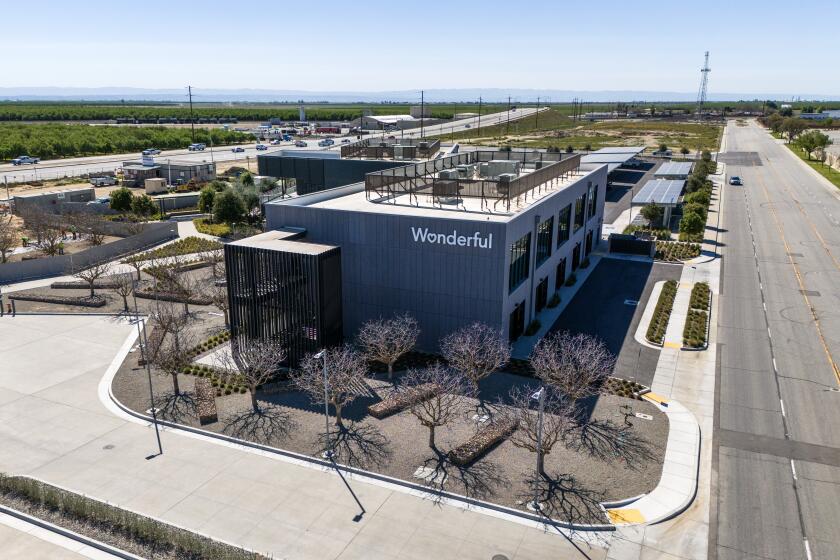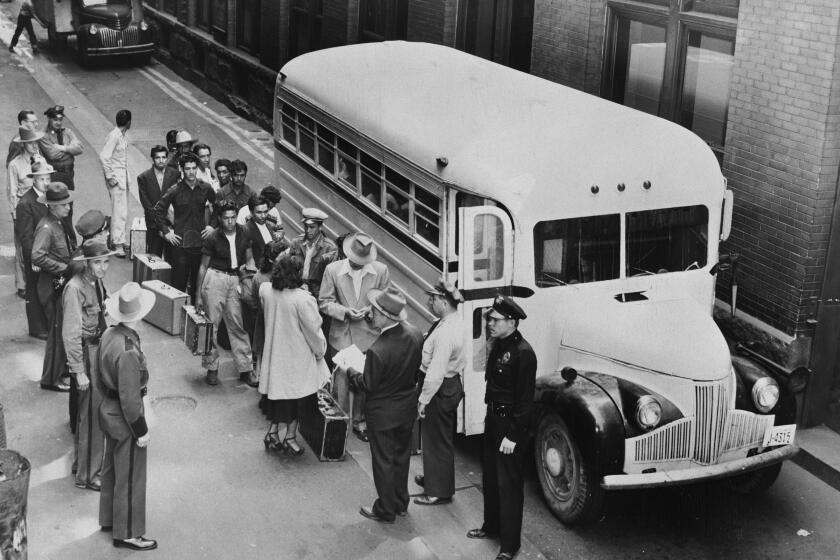Proposal to Sell Imperial Valley Water Stirs Anger
As a poet of the Imperial Valley, Rick Mealey writes triumphantly of the farmers who transformed this stubborn desert into one of the world’s great agricultural regions with the strenuous application of grit and perseverance and enormous amounts of water from the Colorado River.
But the 59-year-old former farmer and dairy rancher is worried that one of his more popular and apocalyptic poems written a decade ago is proving prophetic.
Titled “Imperial Valley 1998. Or: What May Still Happen,” the poem tells how “these great big people” decided Imperial Valley’s water “wasn’t ours/And they needed it all somewhere else/For amusement parks and power” and so the water was sent away and “this valley died too soon.”
What has Mealey’s poetic and political instincts aroused is a high-stakes, high-emotion drama under way in the Imperial Valley, the latest chapter in California’s tug of war over water.
After decades of fighting to gain and safeguard the valley’s rights to Colorado River water, the guardians of the valley’s water are asking farmers to consider something that seems foolhardy to some: Sell some of that water to outsiders and possibly let some fields go dry and lifeless.
The players--political and economic heavyweights all--include the farmers and cattlemen of the Imperial Valley, the Imperial Irrigation District (IID), the billionaire Bass brothers of Texas and the Los Angeles-based Metropolitan Water District, the supplier of 60% of the water used in six Southern California counties.
*
It may seem incongruous to some that Mealey’s Imperial Valley, once so scorched and forbidding that it was called The Valley of the Dead, now enjoys an abundance of water while the rest of Southern California waits breathlessly each year while the snowpack in the Sierra is measured.
When the water barons of Southern California think about meeting the needs of their thirsty constituents, they think longingly of the Imperial Valley: so close, so rich in water, so in need of cash.
MWD already has one water purchasing agreement with IID and might be open to another. Officials at the San Diego County Water Authority are negotiating with IID to buy water, a plan that could require San Diego to build a 125-mile pipeline over the Laguna Mountains.
As Mealey’s verse attests, any talk of selling water in the Imperial Valley is bound to be controversial.
The controversy is fanned considerably by the involvement of the high-rolling Bass brothers. The brothers, who diversified and greatly multiplied their daddy’s oil fortune, have a formidable reputation for boldness in new markets and not taking no for an answer.
In recent years, the Basses bought upward of 30,000 acres of Imperial Valley farmland, making them the region’s second-largest landowner. When their representative started talking of the money to be made by selling water, the cow feed hit the fan.
Smack in the middle of the furor is the IID, one of the state’s oldest water agencies, formed in 1911 so that the valley’s water decisions would be made by a public agency rather than get-rich-quick speculators. It was IID that oversaw construction of the dams, canals and power plants that made possible the agricultural miracle that is the modern Imperial Valley.
The IID acts as trustee for the valley’s water rights. Farmers can use all the water they need but cannot sell a drop without approval of IID, although its power to restrict the rights of landowners has never been tested in court.
Some agribusinessmen fear that selling water to the highest bidder could undermine the Imperial Valley’s billion-dollar agricultural economy, providing windfall profits to a few absentee landowners but forcing the mass of residents to cope with stagnation.
“In the Imperial Valley, the whole damn thing is built on water,” said former county Supervisor Cliff Hurley. “You tinker with water, you’re risking it all.”
“We feel we’re losing control of our destiny,” said Louise Willey, a prominent farmer and feedlot owner in the Imperial Valley for half a century.
Michael J. Clinton, the newly hired general manager of IID, believes water marketing is inevitable, given the pressures on agricultural regions throughout California to sell water to more densely populated areas. The IID board has talked of possibly selling up to 500,000 acre-feet of water annually, enough water to satisfy the needs of 2.5 million urban and suburban residents.
Clinton is confident that water marketing can provide millions of dollars to solve some of the valley’s chronic problems, including the undercapitalization of farms, high unemployment, high electric bills and flooding in the Salton Sea.
Only landowners who voluntarily agreed to be part of the marketing plan would be asked to cut back on their water use and would split their water profits with IID.
Still, Clinton is not surprised by the uproar over the water marketing policy being developed by his bosses on the IID board. Sharing water, even for a profit, runs deeply counter to the local grain.
“There’s an old [frontier] saying,” said Clinton. “It goes: ‘I’ll loan you my wife or my wallet, but ask for my water and you’ll get my gun.’ ”
*
Talk of transferring water from a rural area to an urban one inevitably brings up the Owens Valley scandal in the early part of this century where, by foul means and fair, landowners were persuaded to sell their water so it could be pumped to far-off Los Angeles. The Owens Valley dried up so that Los Angeles might grow.
“What the Bass brothers are doing in the Imperial Valley is the same as what Los Angeles did in the Owens Valley,” said Tom Levy, general manager/chief engineer of the Coachella Valley Water District.
In terms of cooling the controversy, it does not help that Clinton, before being hired by IID, worked as a water-marketing consultant for the Bass brothers and put together a seminar at their behest on water rights and the Colorado River.
Neither does it help that one of the IID board members--one of the two farmers on the five-member board--has sold property to the Bass brothers.
With only one exception, board members agree with Clinton that water marketing is inevitable and that it behooves IID to cut the best deal possible with Los Angeles, San Diego or other would-be buyers rather than wait for the courts or the politicians to act by fiat.
If a filmmaker were casting characters whose presence was liable to stir suspicion in the tightly knit agricultural community of Imperial Valley, it would be hard to find a better bunch than Sid, Robert, Ed and Lee Bass of Fort Worth, Tex.
The brothers are publicity-shy to the point of reclusiveness and known to move fearlessly into new ventures and quickly become major players. They have major holdings in farming, oil, cattle, hotels, real estate, the stock market and the savings-and-loan industry.
The brothers engaged in a takeover bid for Marathon Oil and ended up with a $160-million profit. To fend off a possible takeover, Texaco paid $450 million to buy shares owned by the Basses, a tactic known in some circles as “greenmail.”
One brother is credited by some analysts for saving Walt Disney Co. from corporate raiders and installing Michael Eisner as boss. Another brother funded the biosphere experiment in Arizona. One gave $25 million to Stanford University, and one gave $20 million to Yale but later withdrew the bequest.
In the Imperial Valley, the Bass entity is Western Farms and its spokesman is a quiet-spoken Texan named Ardon Moore. For months, he’s been telling residents of Imperial Valley that the Bass brothers did not start buying land in the valley to turn a quick profit through water sales.
Western Farms, Moore says to anyone who will listen, wants to farm and raise cattle, as well as participate in any water-marketing plan that the IID board devises.
“As a long-term investor in the Imperial Valley, we like our position,” Moore said. “We put our money where our mouth is, and our chips are on the table.”
*
Through a confluence of political, legal and engineering feats that stretch to the end of the last century, the Imperial Valley has the right to use more Colorado River water than any region in three western states.
IID was pulling water out of the Colorado River before the Hoover Dam was built or the Metropolitan Water District was formed. Thanks to a legal doctrine called “first in time, first in right,” IID has water rights that are the envy of Southern California.
Should there ever be a cataclysmic drought, Imperial Valley has the right to take its allotment before a gallon goes to the MWD, whose member agencies serve 16 million people in Los Angeles, Orange, San Diego, San Bernardino, Riverside and Ventura counties.
For its half-million acres of crops and 130,000 residents, Imperial County uses nearly 3 million acre-feet of water from the Colorado River. MWD, by comparison, gets up to 1.3 million.
Until recently, there was no incentive for Imperial Valley farmers to conserve water.
That incentive was supplied a decade ago when the state Water Resources Control Board ruled that the district was wasting water through seepage in the 82-mile-long All-American Canal, 1,442 miles of lateral canals and 1,457 miles of drainage ditches.
With that as a prod, the IID reached a historic agreement with MWD in 1989 to avoid having is water rights trimmed. MWD is paying more than $250 million to line sections of the canals and install other water-saving devices. In turn, MWD gets the right to increase its draw from the Colorado by 106,000 acre-feet annually.
For IID to sell even larger amounts of water either to MWD or San Diego, it would be necessary to save water “on farm.” Some of those savings could be accomplished by planting less water-needy crops or lining ditches.
After that, it could be necessary to leave a portion of their fields unplanted--a practice known as fallowing. When MWD bought water from the Palo Verde Water District, a quarter of the farm acreage around Blythe was fallowed.
Fallowing, Clinton said, has become “a four-letter word in the Imperial Valley.” It raises the specter of large tracts of farmland being allowed to become dry and weed-eaten, and businesses such as crop-dusters, irrigators, pest control specialists, equipment sales companies and tile companies going bankrupt.
The IID board, reacting to the outcry from farmers, no longer talks of fallowing but rather of “rotational set-aside,” which some farmers dismiss as a thin euphemism for fallowing.
Details of how water sales will work have not been determined. One issue yet to be resolved is whether IID has the power to block a landowner--the Bass brothers or anybody else--from fallowing part of their land to get a split of the water-sales profits.
Moore insists that Western Farms is interested in farming, not fallowing, and that anyone who says otherwise is just trying to scuttle water marketing. “There are a few who would use scare tactics to deny the Imperial Valley a chance to bring new money into the agricultural community and new money in for economic development,” he said.
A representative of the Bass brothers has met recently with the deputy general manager of MWD and with Rep. Duncan Hunter (R-El Cajon), who represents the Imperial Valley, to discuss water marketing.
Richard Howitt, professor of agricultural economics at UC Davis and a co-author of the recent book “Sharing Scarcity: Gainers & Losers in California Water Marketing,” thinks the fears of the Imperial Valley farmers, while understandable, are not realistic.
Like the IID’s Clinton, he thinks hunkering down would be the riskiest strategy for Imperial Valley. “The surest way to lose your water in modern California is not to sell it,” he said.
Howitt said he doubts that water will fetch anywhere near the prices being bandied about in the Imperial Valley. And he doubts there will be a stampede of landowners to sell water rather than raise crops because, except in the case of chronically “bad dirt,” farming will be more profitable.
Those farmers who decide to take part of their marginal land out of production will, by sharing in the water-sales profits, make money to help their overall operation stay in business, Howitt said. “I would be very surprised if water marketing didn’t help the farm economy of Imperial Valley more than hurt it,” he said.
Among some outspoken Imperial Valley farmers, however, it is an article of faith that if the valley begins selling water, the urban buyers will decide the water was theirs to begin with and they should not have to pay for it.
“They’ll rewrite the law if they need to, and they’ll have the votes to do it,” said Carson Kalin, who farms 2,500 acres with his family.
Officials from Metropolitan Water District say that, with reservoirs 87% full, they are not looking to buy water from the Imperial Valley although they are willing to talk about the future.
“We’re open to proposals from IID or any agency that uses Colorado River water,” said Jan Matusak, principal engineer in the planning and resources division.
*
Bill Condit, chairman of the IID board, predicts that water marketing will be a major boon to the Imperial Valley, whether the buyer is MWD or the San Diego Water Authority.
“We will be hailed if we survive long enough to get an agreement,” Condit said. “If they don’t hang us first.”
The poet Mealey, who once ran for IID board, counters that Condit and the others are being careless with the heritage of pioneers who busted the soil, suffered through the 110-degree summers before air-conditioning and fought legal and political battles in Sacramento and Washington. His family lived in the Owens Valley until it dried up.
“If they don’t watch out,” Mealey said, “there won’t be nothing left in this valley except a gas station and a Circle K near the freeway.”
More to Read
Sign up for Essential California
The most important California stories and recommendations in your inbox every morning.
You may occasionally receive promotional content from the Los Angeles Times.






